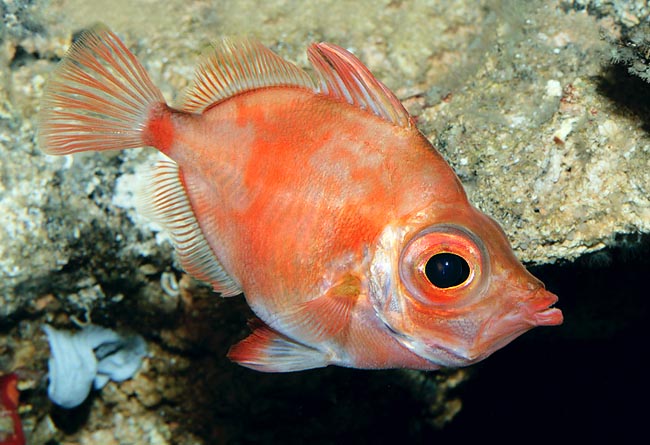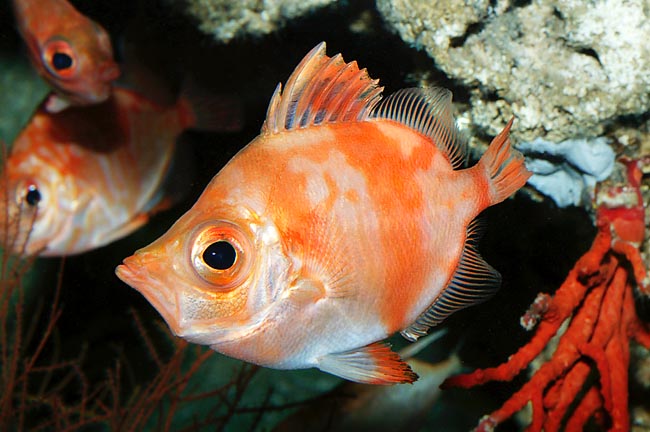Family : Caproidae

Text © Giuseppe Mazza

English translation by Mario Beltramini

Capros aper has big eyes as living between 40 and 700 m of depth © Giuseppe Mazza
The Boarfish, “Pesce tamburo” (Drum fish) in Italian, (Capros aper Linnaeus, 1758), belongs to the class of the Actinopterygii, the ray-finned fishes, to the order of Zeiformes for some, or of Perciformes for others, and to the family of Caproidae which counts this species only.
The name of the genus comes from the Latin “capra” = goat.
The name of the species “aper” in Latin means boar. And, as a confirmation, in French the boarfish is called “Poisson sanglier”, that is, Boar fish.
It is difficult to find a minimum common denominator between these things, apart the human fantasy. By sure, the profile of the snout recalls a goat, that of the body a boar and is roundish like a drum.
Zoogeography
It is present in all the Mediterranean, Black Sea included, even if here its density is modest. After Gibraltar Strait it goes northwards along the eastern Atlantic coast up to Scandinavia and reaches, southwards, the Senegal, colonizing the Azores, Canary, Madeira and Cape Verde Islands.
Ecology-Habitat
It lives along the coasts, on the corraligenous depths, but also on the gravelly and muddy bottoms, between the 40 and the 700 m of depth.
Morpho-physiology
It can be 30 cm long, but rarely exceeds the 15 cm. The body is discoidal, much compressed on the sides, with tiny scales with a velvety look, but rough to the touch, just like sandpaper. Proportionally, the eye is huge, for granting good visibility in the darkness; and to support the thesis of those placing it in the Zeiformes, the fins retrace the pattern of those of the Zeus faber.

Rarely exceeds 15 cm, but recalls Zeus faber and like this one has a very protractile mouth © Giuseppe Mazza
A dorsal fin with 9 showy spiny rays, well separated in the structure from the adjacent 23-25 soft rays, an anal fin with 3 spiny rays and 22-23 unarmed, and two ventral fins, also rather big with a spiny ray and 5 soft with bifurcated extensions. And, as for the St. Pierre, also if in a definitely lesser tone, the soft part of the dorsal and the anal are reinforced on both sides, at the base, by particular scales, which even if not prickly, are in any case biting. Also the caudal fin, roundish and spatulate, is similar, but the pectoral ones are proportionally bigger.
As Zeus faber it has a very protractile mouth, covered by tiny teeth on the jaws and on the vomer.
The dominant colour is pink, darker on the back, more silvery on the sides, with bands and spots tending to the red-orange which interest also the fins.
Ethology- Reproductive Biology
Not less greedy than St. Pierre, the boarfish surprises the preys with the mouth which suddenly extends, like a pipe. But, seen its modest size, these are not fishes or squids, but small crustaceans, mainly copepods and planktonic forms, integrated, when it’s the case, by some small worm or mollusc.
The Capros aper lives in schools. The males are smaller than the females. In the Mediterranean, it reproduces between April and June, whilst, northwards, in the Channel, the eggs are spawned two months later and in Ireland starting from July. They are pelagic, little more than 2 mm broad and are floating.
The post-larval stages let already perceive the shape of the parents, and when about 4 cm, the juveniles are absolutely similar to the adults. The vulnerability index of this species is of 51 over 100.
Synonyms
Perca brunnich Lacepède, 1802; Perca pusilla Brünnich, 1768; Zeus aper Linnaeus, 1758.
→ For general information about FISH please click here.
→ For general information about BONY FISH please click here
→ For general information about CARTILAGINOUS FISH please click here.
→ To appreciate the BIODIVERSITY of BONY FISH please click here.
→ To appreciate the BIODIVERSITY of CARTILAGINOUS FISH please click here.
